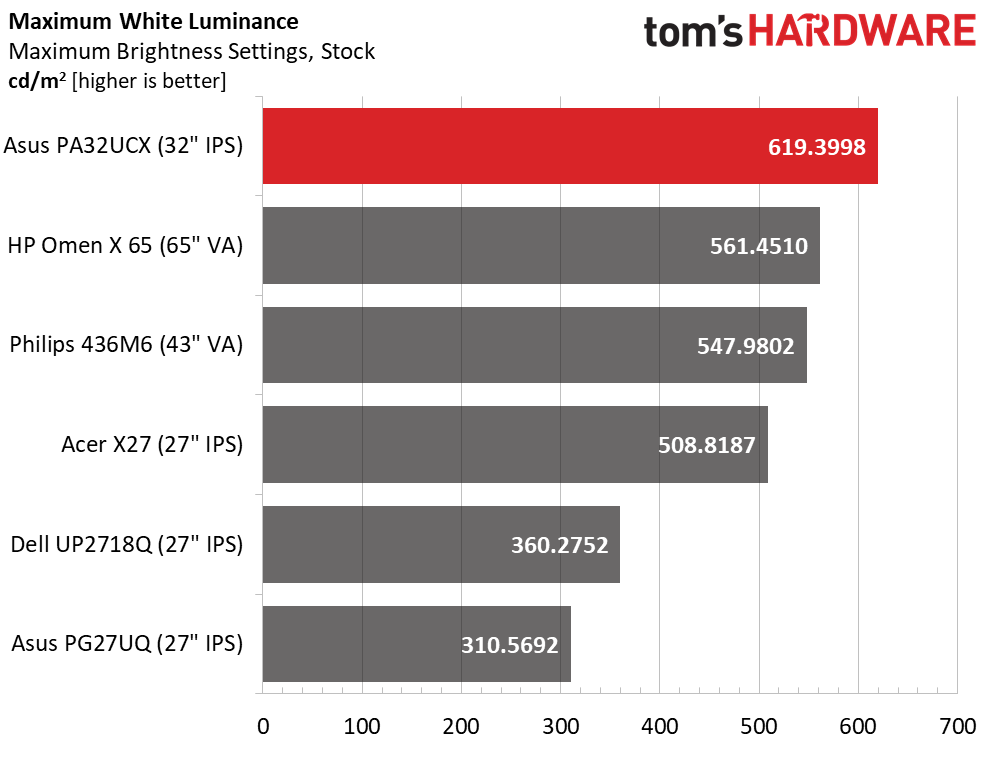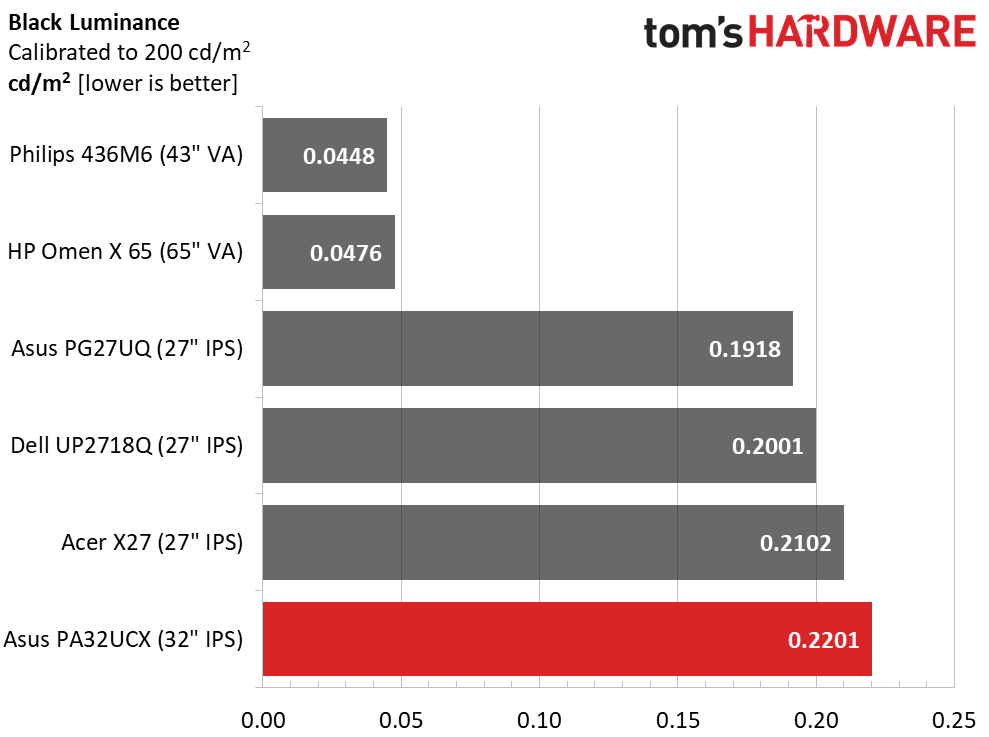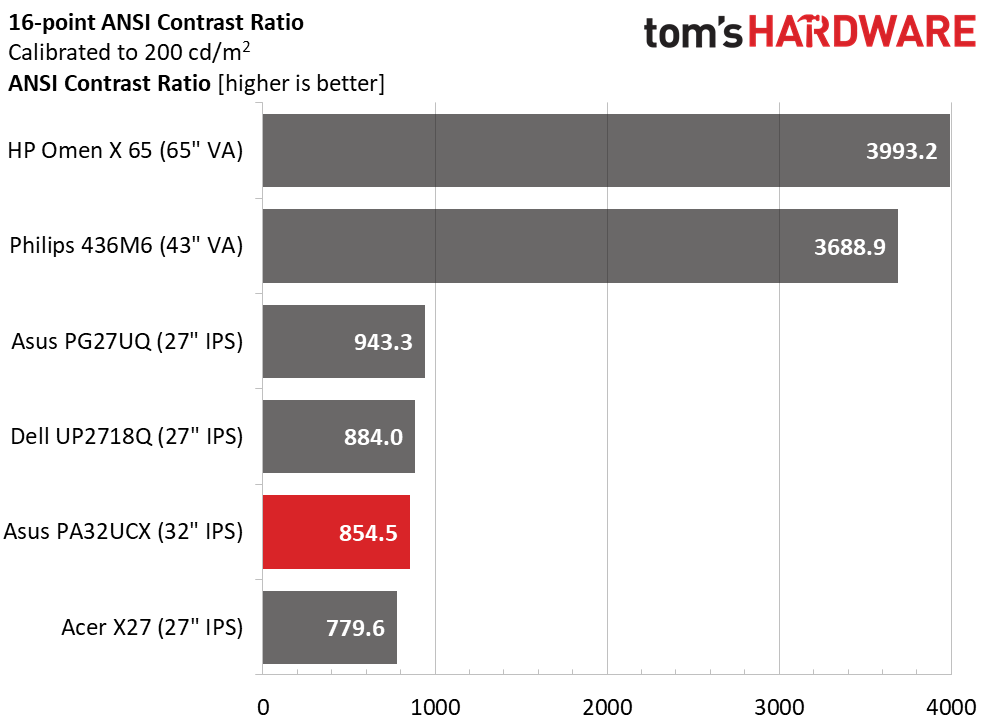Why you can trust Tom's Hardware
To read about our monitor tests in-depth, check out Display Testing Explained: How We Test Monitors and TVs. We cover brightness and Contrast testing on page two.
Uncalibrated – Maximum Backlight Level
There is nothing in our database that truly rivals the PA32UCX’s performance and its groundbreaking backlight. However, for comparison we rounded up a group of monitors that can hit 1,000 nits brightness with HDR. We have the FALD-equipped Acer Predator X27, Asus ROG Swift PG27UQ, Dell UP2718Q and HP Omen X 65 Emperium -- all with 384 dimming zones and wide color gamuts. The wild card is a Philips 436M6VBPAB Momentum, a VA screen with a wide gamut and 1,000-nit capability but with edge lighting.



The PA32UCX is rated for 600 nits in SDR mode but easily exceeded that with over 619 nits. This is helpful when using the zone dimming feature for SDR content because it bumps up highlight detail and makes brighter content pop without increasing black levels. With 1,152 dimming zones, you’ll never see gray blacks, even when the backlight is turned up to maximum.
Our SDR contrast result -- 901.3:1 -- shows the panel’s native contrast with zone dimming turned off. The only time one would turn off zone dimming is during calibration. The high black level (0.69 nit) is no surprise, given the PA32UCX’s extreme brightness capability.
After Calibration to 200 nits



Sequential contrast after calibration was similar to our earlier result (897:1 versus 901:1 before calibration). We adjusted the Rec.709 mode with small changes to the RGB gain and bias controls. They start at center-range and allow for a precise and balanced adjustment. VA panels’ advantage in native contrast is clear, with the Philips and HP screens topping the black level and contrast tests above.
The PA32UCX’s ANSI score (third chart above) was fairly close to its sequential result (855:1 versus 891:1). This is to be expected from such a high-quality panel. Turning on the zone dimming didn’t affect this score, as we used a checkerboard pattern with a 50% average picture level.
MORE: Best Gaming Monitors
Get Tom's Hardware's best news and in-depth reviews, straight to your inbox.
MORE: How We Test Monitors
MORE: All Monitor Content
Current page: Brightness and Contrast
Prev Page Features and Specifications Next Page Grayscale, Gamma and Color
Christian Eberle is a Contributing Editor for Tom's Hardware US. He's a veteran reviewer of A/V equipment, specializing in monitors. Christian began his obsession with tech when he built his first PC in 1991, a 286 running DOS 3.0 at a blazing 12MHz. In 2006, he undertook training from the Imaging Science Foundation in video calibration and testing and thus started a passion for precise imaging that persists to this day. He is also a professional musician with a degree from the New England Conservatory as a classical bassoonist which he used to good effect as a performer with the West Point Army Band from 1987 to 2013. He enjoys watching movies and listening to high-end audio in his custom-built home theater and can be seen riding trails near his home on a race-ready ICE VTX recumbent trike. Christian enjoys the endless summer in Florida where he lives with his wife and Chihuahua and plays with orchestras around the state.
-
TheDane I know it is specified (in a smaller font below the title) but I'd prefer if you didn't use the term "mini-LED 4K HDR monitor" in the main title as this isn't a new type of panel, just an LCD panel with more zones. It confuses some people (like those who don't know that LED display are also just LCD panels with another type of backlighting).Reply -
JamesSneed ReplyTheDane said:I know it is specified (in a smaller font below the title) but I'd prefer if you didn't use the term "mini-LED 4K HDR monitor" in the main title as this isn't a new type of panel, just an LCD panel with more zones. It confuses some people (like those who don't know that LED display are also just LCD panels with another type of backlighting).
I could see that. Something like "4K HDR monitor with mini-LED backlight" would be much more forthcoming and less confusing imo. -
jasonelmore Oh wow, this thing is 4 grand. I'd love to see this technology come to Asus's Gsync line.Reply -
strongdc I'd like to see this go against Apple's new Pro Display. That also uses mini-LEDs and beats it in every spec.Reply -
TheDane 1400 zones vs 576 zone - no not in all metrics.Reply
I'll wait for the microLED TVs/monitors, after using OLED TVs for some time I just cannot see myself use LCD panels again. And microLED looks to have all the benefits of OLED (per-pixel-light) and no potential issues with retention (though my OLED TV still looks fine after 2 years of daily use). -
setx Those on screen controls... are pure cancer as usual. Even with top level hardware they don't bother to make them convenient to use.Reply
After using NEC advanced mode it feels like going from IPS to TN panel. -
cryoburner Reply
I agree, when I first clicked the article, I thought it was going to be a review for a MicroLED screen with individual LEDs making up each pixel element, but quickly discovered it was just another IPS screen, albeit with somewhat more local dimming zones for HDR. Meh. A 24x48 array of backlight LEDs on a 32" screen isn't exactly what I would call "mini".TheDane said:I know it is specified (in a smaller font below the title) but I'd prefer if you didn't use the term "mini-LED 4K HDR monitor" in the main title as this isn't a new type of panel, just an LCD panel with more zones.
I guess MicroLED is still a couple years or so away from mass production though, and will probably only appear at low pixel densities initially, like for big-screen TVs. It will probably be a number of years before we see a 32" 4K MicroLED screen. -
mohammed2006 toms hardware should have included sony BVM-HX310. to see how close it get to it. i need to upgrade my dell UP2718Q i am thinking ether asus or apple . please do asus vs apple and add Sony BVM-HX310.Reply -
jonpais Does the Asus require an i/o converter to use as an HDR reference grading monitor with a Mac?Reply -
crimsonfilms Replymohammed2006 said:toms hardware should have included sony BVM-HX310. to see how close it get to it. i need to upgrade my dell UP2718Q i am thinking ether asus or apple . please do asus vs apple and add Sony BVM-HX310.
What?
The BMV-HX310 is $32K discounted. It does not even occupy the same market space.